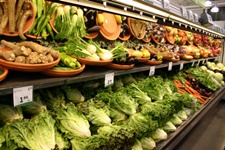 One of the best places to start improving your health is the grocery store. It can keep you out of the doctor’s office or the hospital, and it’s much more cost-effective than going to the pharmacy. Most of us don’t look at the grocery store as health mecca, but the truth is, it’s the ultimate health food store!
One of the best places to start improving your health is the grocery store. It can keep you out of the doctor’s office or the hospital, and it’s much more cost-effective than going to the pharmacy. Most of us don’t look at the grocery store as health mecca, but the truth is, it’s the ultimate health food store!
I’m sure some of you are saying, “Yeah, right. How can it be a health food store when it’s full of cookies, chips, and soda?” and you’re right. The grocery store is also one of the worst places for your health. The key is knowing how to navigate it. When you learn how, you’ll quickly turn your daily shopping into healthy shopping. Knowing how to navigate the aisles of your grocery store can improve your health and save you money.
It may sound strange, but I like to think the grocery store resembles a healthy donut. Now, bear with me here and let me explain: all the good stuff surrounds a big empty hole. In order to improve your health and save money, it’s wise to become a perimeter shopper.
You’ve probably noticed the perimeter of the grocery store is where all the nutritious foods are. It’s where you’ll find the fruit and vegetables, protein-rich meats and fish, milk, yogurt, and, for the most part, all the items that are free of preservatives and added sugar. It’s where the natural food resides. Once you start venturing down the aisles, you’ll find sweets, processed foods, and countless other items packed with sugar and sodium that will attack your wallet and your health.
When something comes in a can or a package, you can almost count on the fact that it’s not good for you. If it’s easily stackable on an aisle shelf, it’s likely been processed and packed with sugar or sodium—the evil empire of health. These two ingredients are the main culprits of diabetes, heart problems, and obesity-related illnesses in America.
Now, you may feel like it’s impossible to make the switch to a diet based entirely on fresh, whole foods—but you don’t have to. Instead, start by gradually changing your eating habits—and the first step is shopping around the perimeter of your grocery store. When you do venture into the middle aisles, make sure you make the best possible choices by reading labels carefully.
MORE: The right way to read food labels
The things you want to make special note of when checking out food labels are: the serving size, sodium content, amount of added sugar, and calorie content. In most cases, you’ll end up having to multiply this information a few times to calculate the nutritional information of what you will be consuming. Are you really going to have one tablespoon of dressing? Probably not.
The cost comparison between fresh and processed foods has long been the cause for great debate. However, here are a few things to think about:
• The more nutritious your diet is, the richer your nutrition is. This means you don’t need to spend money on supplements because you’ll be getting the vitamins, minerals, and amino acids you need just from your food.
• Many health problems are directly tied to your diet. By eating foods low in sodium and added sugar, you can end up saving all kinds of money on health-related expenses.
• Fresh food can be preserved in the freezer and saved for later—another great way to avoid buying sodium-filled frozen meals.
• Over time, eating fresh food is likely to be cheaper.
Source(s) for Today’s Article:
“Public health takes aim at sugar and sale,” Harvard Public Health, Fall 2009; http://www.hsph.harvard.edu/news/magazine/sugar-and-salt/.
